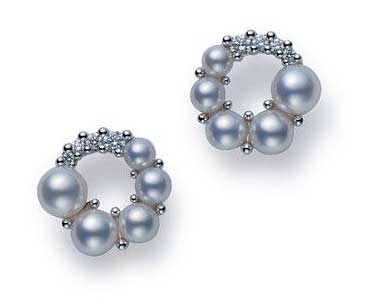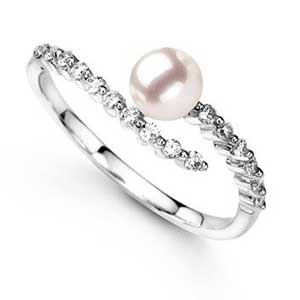Akoya Pearls – What They Are, and What You Should Know Before You Buy That Akoya Pearl Necklace
There are so many different types of pearls on the market, it can sometimes be confusing when you actually shop online or head out to shop for them. Akoya pearls are just one type of saltwater pearl that many women love for their extraordinary beauty.
I love Akoya pearls because they are so beautiful, and I’m guessing that’s what you like about them also. They have a perfectly round (well, almost perfectly round, as you will see later) shape, a beautiful mirror-like luster, and they come in the soft neutral white and cream colors that we all love the most in our pearls.
You can definitely find other pearls on the market that are pretty and affordable, so what is it that makes Akoya cultured pearls so special?

Where Japanese Akoya Pearls Come From
Before I begin, I have to preface this explanation with the fact that Akoya pearls can come from countries other than Japan, like China, Viet Nam, Australia South Korea, for instance. Most of the Akoya cultured pearl necklaces, rings and bracelets on the market used to come from Japan, but that is changing. More about that in a bit.
In the early 20th century, Kokichi Mikimoto developed a newly patented technique for creating cultured pearls. He used a specific mollusk called Pinctada fucata martensii, which is also known as the Akoya oyster. To create Akoya pearls, a small mother-of-pearl bead, along with a piece of mantle tissue (the thin membrane by which a mollusk is attached to its inner shell) is inserted inside the gonad (reproductive organ) of the mollusk. The mollusk begins secreting a substance called nacre that coats the bead, and with time, the new pearl grows to a size of between 2 and 11 millimeters. Most Akoya pearls never get any bigger than that because the Pinctada fucata martensii mollusk is one of the smallest pearl-producing mollusks in the sea.
One important thing to remember is the fact that Akoya pearls are cultured saltwater pearls. Cultured pearls can also come from freshwater sources, but if any pearl is labeled to be a freshwater Akoya pearl, it is being misrepresented and should be avoided.
In the past, most Akoya pearls were from Japan, but since their name is really derived from the type of oyster in which they are cultured, these gorgeous gems can come from anywhere and still be correctly identified as true “Akoya pearls” as long as they were cultured in an Akoya oyster in saltwater.
For much of the 20th century, Japan was the place to get any type of cultured pearls from, and they continue to be a major force in the industry. Now, however, China has also become a major player in the field and the quality of their Akoya pearls has equaled the quality of the Japanese variety for the last decade or so. One difference seems to be the size of pearls that each country does best; Japan is still best at culturing larger Akoya pearls, and China is best at culturing smaller pearls. In fact, most of the Akoyas in the market today that are smaller than 8mm are from China.

Chinese or Japanese Akoya Pearls?
This brings up a question that many consumers have, which is how to tell a Japanese from a Chinese Akoya pearl, especially after they have been strung or mounted in a setting. The answer to that is that many times it is impossible to tell. Here is what sometimes happens: pearls from China are imported to Japan, treated with industry accepted treatments, strung or set into jewelry pieces, and then marketed as “Japanese Akoya Pearls”.
So, remembering that most of the smaller Akoyas are now cultured in China, the long and short of it is this; if you buy Akoya pearls that are smaller than 8mm, more than likely they originated in China, even if they are labeled as Japanese Akoyas.
Looking for the Best Akoya Pearls?
Just like gemstones, pearls are also graded on their quality or lack thereof. Before you head out to buy that Akoya pearl necklace or Akoya pearl earrings you have had your eye on, make sure you know some things about how they are graded first so you can make an informed decision.
The AAA grading scale is currently the most internationally recognized Akoya pearl grading scale in existence. Here is the AAA scale in chart form:
AAA graded pearls comprise about 3-5% of the cultured pearl harvest worldwide, according to Stephen Couch of Pearls by Angela Carol online. He notes that AAA quality pearls must be 95% inclusion free, meaning that no more than 5% of the surface area of the pearl may be affected by blemishes, pinpoints, or other imperfections.
Always inquire about or search the website you are going to buy your pearls from to find out how the grading system they use works. If they don’t use the AAA system, make sure you know what the grade they use for any Akoya bracelet, necklace, etc. that you are considering buying corresponds to on the AAA grading system. That way you can determine the true quality of the piece.
Below is pictured a strand of Akoya pearls that have been graded as AA pearls. Note that the luster (shine) on the pearls is not quite “mirror-like”, hence the lower rating for them. Pearls like these are common and can be found in most jewelry stores.
Hanadama Akoya Pearls – The Absolute Best
The top 1% of all pearls produced are considered to be Hanadama pearls and are very rare and as you might expect, expensive. Jeremy Shepard of Pearl Paradise shared this information about Hanadama pearls on pearl-guide.com recently:
A Hanadama certificate for Akoya pearls can only be produced in one place: Japan. Pearls are examined on their outer surface by high magnification, their interiors are inspected through an optical fiber, a spectrophotometric reflectance test is administered, and a soft x-ray is made of the pearl. The thickness of the layers is measured, which must measure at least .4 on each side of the pearl for a total of .8 and the Teri-value, or luster, and the kizu, or % of imperfections is also determined.
To be graded as a Hanadama, the Teri-value has to be “strong”, and the kizu must be determined to be “very slightly”. You should note that the highest kizu any pearl can receive is “very slightly” since all pearls are organic and therefore have imperfections.
Entire strands of pearls are graded together, and when each pearl on the strand is graded high, the whole strand is then given the grade “Hanadama”. This is a term that is used only for Akoya pearls, and more often than not, the pearls will be in the 7.5 – 8mm to 8.5 – 9mm size range.
A Hanadama certificate is pictured below:

Treatments Applied to Akoya Pearls
There are treatments that are commonly applied to pearls, and Akoya pearls are no exception. They may be beached, and especially in the case of Akoyas, they are usually “pinked”. Bleaching usually involves applying peroxide to the pearls to help improve their color and pinking is the application of dye to the pearls to add a tiny bit of pink to the overall tone of the pearl.
Both treatments are considered to be acceptable by industry standards and should be disclosed to the buyer according to many experts in the field, but neither of these treatments is usually disclosed. Pinking is so common that Akoya pearls are assumed to have been pinked unless their certificate specifically states that they are natural and have not been pinked. That said, it is possible to find completely natural pearls in the last few years due to the better culturing techniques being developed. These pearls will be, of course, very expensive.

Akoya Pearl Overtones
Since they are organic gemstones, there are subtle color differences from pearl to pearl. After the above treatments are applied, the pearls are carefully separated and grouped according to the color overtones they carry. Most Akoyas carry either cream, rose or silver overtones, and most women like to select the overtone according to what looks best on them. In general, remember this:
- Fair skin: rose overtones
- Medium to Dark skin: cream or silver overtones
Of course, this is an absolutely personal preference at this point, and the overtones carried by your pearls will have no bearing on their overall value, so pick whichever color overtone you love the best.
Caring for Your
One of the best things you can do for your pearls is to wear them often. They are organic and will not be adversely affected by your skin oils; in fact, the oil from your skin will actually be good for your pearls.
Here are some things that are not good for pearls:
- Heat/Dryness
Never leave pearls in a hot environment, or in the sun. Hot air is usually dry air, so avoiding excessive heat will also avoid excessively dry air. Storing in a plastic bag can keep natural humidity from pearls, causing them to dry out.
- Humidity/Moisture
As much as pearls don’t like dryness, continuous exposure to excessive humidity is not good for them either. Store pearls in a dry environment. Don’t leave them in a box in the bathroom, for instance.
- Chemicals
Chemicals include things like cleaning products, cosmetics, lotions, hairspray, perfume, etc. Always apply cosmetics, perfume, and hairspray before putting on your pearls, making sure they are completely dry before putting on your jewelry. Never use products like bleach, vinegar or other cleaning sprays while you wear your pearls, no matter what June Cleaver says. Chlorine is a form of bleach, so never expose pearls to swimming pool water. Salt is also a chemical that can harm your pearl jewelry, so definitely remove them before you do anything that will make you sweat. I leave the definition of what will make you sweat up to you.
- Hanging in a Jewelry Box
Always place pearls in a soft cotton pouch or wrap in tissue and they lay flat in your jewelry box. Hanging them up will cause the silk thread on which they are strung to stretch over time.
Keeping pearls clean is easy. Every time you remove them, gently wipe them with a soft, lint-free cloth before storing them properly. Once in a while, you can wash your pearls with filtered water (so there’s no chlorine in it) and a mild soap such as castile soap. Do not use a detergent like you wash your dishes or hands with. Lather up your hands with the castile soap and de-chlorinated water and rub the pearls gently between your hands. Rinse them and lay them on a soft towel to dry. Make sure to move them at least once while they dry to a dry spot on the towel.
Especially if you wear a bracelet or strand of pearls frequently, take them to a trusted jeweler and have them inspected about once a year. They will be able to spot problems and make repairs so you don’t have to worry about the clasp detaching or the cord breaking, resulting in you losing your beautiful pearls.
You Get What You Pay For, Especially When it Comes to Pearls
Many retail jewelry shops carry pearl pendants that are beautiful and that are very affordable, but to find a true Akoya pearl pendant or an Akoya pearl bracelet you may have to look further than jewelry chain stores. The high quality of Akoya saltwater pearls is not something that can be found just anywhere, so do some research online and in person at reputable jewelry stores in your area and try to find one that specializes in pearl jewelry. They will be able to answer your questions and help you find the pearls of your dreams.
Keep in mind, if you want true Akoya pearls, you will have to pay for them. Even a pair of small 7.5 AAA Akoya pearl earrings will cost about $200. A 7” bracelet of the same quality and size pearls will cost $500 and up, and a 20” single strand necklace of AAA Akoyas will cost $1000 and up. When you consider their glowing beauty and relative rarity, most women who love pearls consider the price of Akoyas to be well worth it.
Isn’t it about time you had some Akoya pearls in your collection?
Happy Shopping!
